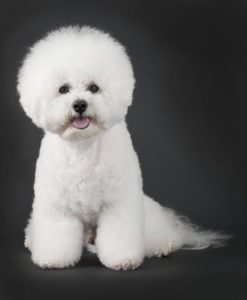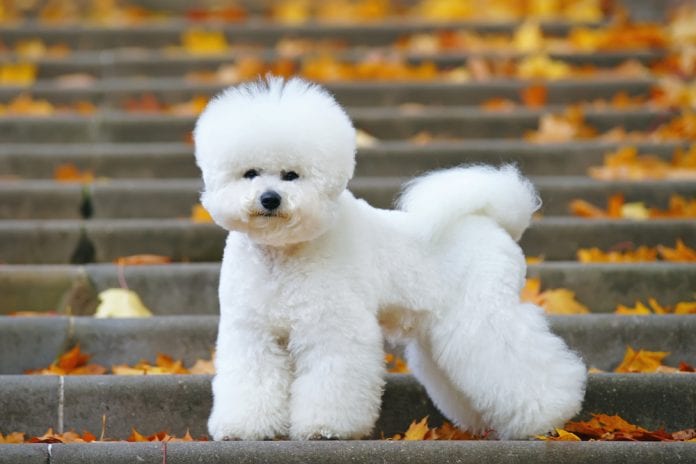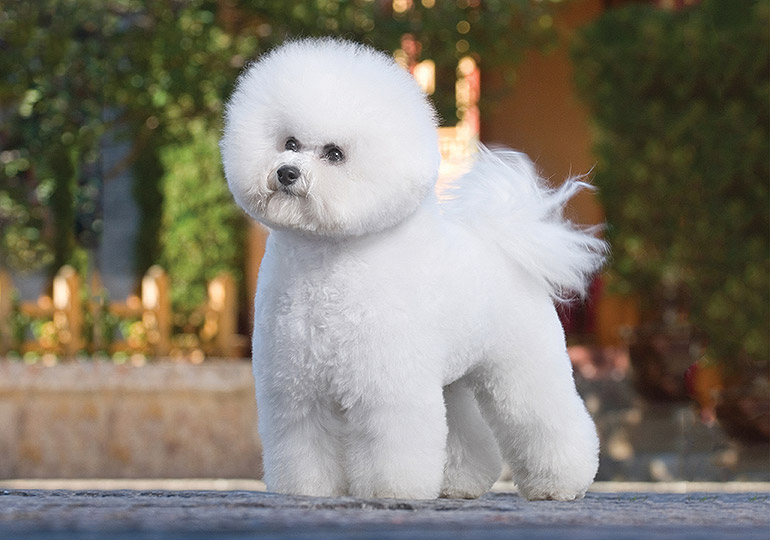A Bichon Frise from French: bichon à poil frisé, meaning ‘curly lap dog’) is a small breed of dog of the bichon type. The Bichon Frise is a member of the Non-sporting Group of dog breeds in the United States, and a member of the Toy dog group in the United Kingdom.
History
The Bichon Frise is often depicted as a French dog. Although the Bichon breed type is originally Spanish, used as sailing dogs, also as herding dogs sometimes, the French developed bichon frise into a gentle lap-dog variety. The Bichon type arose from the water dogs and is descended from the poodle-type dogs and either the Barbet or one of the water spaniel class of breeds. Modern Bichons have developed into four categories: the Bichon Frise or Tenerife, the Maltese, the Bolognese, and the Havanese, often treated as separate breeds.

Because of their merry disposition, the ancestral Bichons travelled much and were often used as barter by Italian sailors as they moved from continent to continent. The dogs found early success in Spain and it is generally believed that Spanish seamen introduced the early breed to the Tenerife in the Canary Islands. In the 14th century, Italian sailors rediscovered the dogs on their voyages and are credited with returning them to continental Europe, where they became great favourites of Italian nobility. As was the style with dogs in the courts, their coats were cut “lion style”, like a modern-day Portuguese Water Dog.
The Tenerife, often simply called the Bichon, had success in France during the Renaissance under Francis I (1515–1547), but its popularity increased in the court of Henry III (1574–1589) when it had become popular amongst French nobility as both a court companion and lap dog. The breed also enjoyed considerable success in Spain as a favourite of the Infantas and painters of the Spanish school often included them in their works. For example, the famous artist, Francisco de Goya, included a Bichon in several of his works.
Interest in the bichon frise breed was renewed during the rule of Napoleon III, but then waned until the late 19th century when it became the “common dog”, running the streets, accompanying the organ grinders of Barbary, leading the blind, and doing tricks in circuses and fairs. After World War I, they had begun to become popular again in France and were bred by French breeders.

On 5 March 1933, the official standard of the bichon frise breed was adopted by the Société Centrale Canine, the national kennel club for France. This was largely due to the success of the French-speaking Belgian author Hergé’s The Adventures of Tintin, which featured a small, fluffy, white fox terrier dog named Milou (Snowy in the English editions). As the breed was known by two names at that time, Tenerife and Bichon, the president of the Fédération Cynologique Internationale proposed a name based on the characteristics that the dogs presented – the Bichon À Poil Frisé, later shortened to Bichon Frisé. (“Frisé” means “curly”, referring to the breed’s coat.) On 18 October 1934, the Bichon Frisé was admitted to the studbook of the Société Centrale Canine.
The bichon frise was brought to the United States in 1955. The first US-born Bichon litter was whelped in 1956. In 1959 and 1960, two breeders in different parts of the US acquired Bichons, which provided the origins for the breed’s further development in that country.
The bichon frise was introduced into Australia in the 1970s and since its introduction has proved successful as both a show and companion dog.
